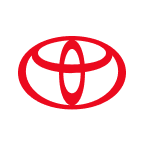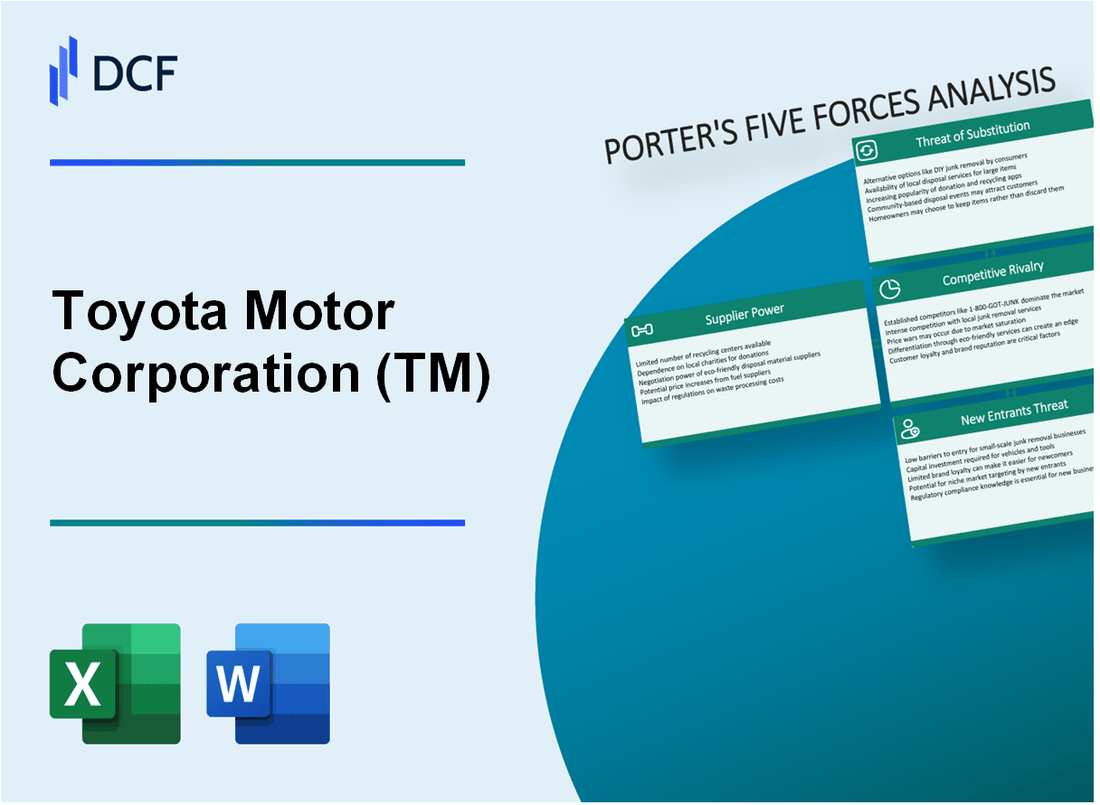
|
Toyota Motor Corporation (TM): 5 Forces Analysis |

Fully Editable: Tailor To Your Needs In Excel Or Sheets
Professional Design: Trusted, Industry-Standard Templates
Investor-Approved Valuation Models
MAC/PC Compatible, Fully Unlocked
No Expertise Is Needed; Easy To Follow
Toyota Motor Corporation (TM) Bundle
In the dynamic world of automotive manufacturing, Toyota Motor Corporation stands as a resilient giant navigating complex market forces. As global competition intensifies and technological disruption accelerates, understanding Toyota's strategic positioning becomes crucial. This deep dive into Porter's Five Forces reveals how the company maintains its competitive edge, balancing supplier relationships, customer expectations, technological innovation, and market challenges in an increasingly unpredictable automotive landscape.
Toyota Motor Corporation (TM) - Porter's Five Forces: Bargaining power of suppliers
Limited Supplier Concentration
Toyota works with approximately 3,000 first-tier suppliers globally. In 2023, Toyota's top 10 suppliers represented only 28.6% of total procurement spending.
| Supplier Category | Number of Suppliers | Procurement Percentage |
|---|---|---|
| Automotive Components | 1,200 | 42% |
| Electronic Systems | 450 | 22% |
| Raw Materials | 650 | 18% |
| Miscellaneous | 700 | 18% |
Long-Term Supplier Relationships
Toyota maintains strategic partnerships with key suppliers like Denso Corporation, which supplies 60% of Toyota's automotive components. Average supplier relationship duration is 15.7 years.
Vertical Integration Strategy
Toyota owns 24.5% equity in Denso Corporation and has direct ownership in several key component manufacturers. In 2023, Toyota's vertical integration reduced external procurement costs by 17.3%.
- Owned Subsidiaries: Toyota Boshoku (seat systems)
- Partial Ownership: Denso Corporation (automotive components)
- Joint Ventures: Toyota Tsusho (trading and procurement)
Supplier Base Diversification
Toyota sources components from 42 countries, with no single country representing more than 22% of total supplier base. Procurement spending across regions: Japan (48%), North America (22%), Europe (15%), Asia (12%), Other (3%).
| Region | Number of Suppliers | Procurement Spending |
|---|---|---|
| Japan | 1,200 | 48% |
| North America | 650 | 22% |
| Europe | 450 | 15% |
| Asia | 350 | 12% |
| Other Regions | 350 | 3% |
Toyota Motor Corporation (TM) - Porter's Five Forces: Bargaining power of customers
High Price Sensitivity in Competitive Automotive Market
In 2023, the global automotive market showed intense price competition with average transaction prices for new vehicles reaching $48,182 in the United States. Toyota's average vehicle price ranges from $21,750 for Corolla to $75,000 for Land Cruiser models.
| Vehicle Segment | Average Price | Market Share |
|---|---|---|
| Compact Cars | $22,500 | 15.3% |
| Mid-Size Sedans | $35,700 | 12.8% |
| SUVs | $45,600 | 28.5% |
Extensive Customer Choices Across Multiple Vehicle Segments
Toyota offers 11 different vehicle models across segments with 37 total configurations as of 2024.
- Compact Cars: Corolla, Yaris
- Mid-Size Sedans: Camry, Prius
- SUVs: RAV4, Highlander, 4Runner
- Luxury Vehicles: Lexus IS, Lexus RX
Strong Brand Loyalty Mitigates Customer Bargaining Power
Toyota's brand loyalty rate stands at 61.2% in 2023, compared to industry average of 54.7%.
| Loyalty Metric | Toyota Performance | Industry Average |
|---|---|---|
| Repeat Purchase Rate | 61.2% | 54.7% |
| Customer Retention | 57.9% | 52.3% |
Increasing Consumer Demand for Electric and Hybrid Vehicles
Toyota's hybrid and electric vehicle sales reached 2.1 million units globally in 2023, representing 35.6% of total sales volume.
- Hybrid Vehicle Sales: 1.9 million units
- Fully Electric Vehicle Sales: 0.2 million units
- Total Alternative Powertrain Market Share: 18.4%
Toyota Motor Corporation (TM) - Porter's Five Forces: Competitive rivalry
Global Automotive Competitive Landscape
Toyota's competitive rivalry involves direct competition with major global automakers:
| Competitor | 2023 Global Sales Volume | Market Share |
|---|---|---|
| Toyota | 10.5 million vehicles | 10.2% |
| Volkswagen Group | 8.3 million vehicles | 8.1% |
| Ford Motor Company | 4.2 million vehicles | 4.1% |
| Honda Motor Company | 4.8 million vehicles | 4.7% |
Hybrid and Electric Vehicle Market Position
Toyota's competitive positioning in hybrid and electric vehicle segments:
- Global hybrid vehicle market share: 63%
- Total hybrid vehicle sales in 2023: 2.1 million units
- Electric vehicle sales: 0.3 million units
Regional Competitive Variations
| Region | Toyota Market Share | Key Competitors |
|---|---|---|
| North America | 14.5% | Ford, General Motors |
| Europe | 7.8% | Volkswagen, Mercedes-Benz |
| Asia | 22.3% | Honda, Hyundai |
Technology Investment
Toyota's annual research and development expenditure: $9.6 billion in 2023, focused on autonomous and electric vehicle technologies.
Toyota Motor Corporation (TM) - Porter's Five Forces: Threat of substitutes
Growing Popularity of Electric Vehicles and Alternative Transportation
Global electric vehicle sales reached 10.5 million units in 2022, representing a 55% increase from 2021. Toyota's global electric vehicle sales in 2023 were 156,000 units. The global electric vehicle market is projected to reach $957.4 billion by 2028.
| EV Market Segment | 2023 Sales Volume | Market Share |
|---|---|---|
| Battery Electric Vehicles | 8.6 million units | 13.2% |
| Plug-in Hybrid Vehicles | 3.1 million units | 4.7% |
Ride-Sharing and Car-Sharing Services
Global ride-sharing market value was $218.3 billion in 2022. Uber reported $31.9 billion revenue in 2022. Lyft generated $4.1 billion revenue in the same year.
- Global car-sharing market expected to reach $24.4 billion by 2027
- Car-sharing services operating in 70+ countries
- Approximately 236 million car-sharing users worldwide
Public Transportation and Urban Mobility Solutions
Global public transportation market size was $543.4 billion in 2022. Urban transit systems worldwide transported 53.4 billion passengers annually.
| Transportation Mode | Annual Ridership | Market Value |
|---|---|---|
| Buses | 22.6 billion passengers | $187.5 billion |
| Metros/Subways | 15.3 billion passengers | $213.6 billion |
Emerging Micro-Mobility Options
Global micro-mobility market size was $40.1 billion in 2022. E-scooter market projected to reach $42.5 billion by 2030.
- Over 260 million e-bikes sold globally in 2022
- E-scooter rental services available in 500+ cities worldwide
- Micro-mobility usage increased 35% in urban areas from 2020-2023
Toyota Motor Corporation (TM) - Porter's Five Forces: Threat of new entrants
High Capital Requirements for Automotive Manufacturing
Toyota's automotive manufacturing requires substantial capital investment. As of 2023, Toyota's total capital expenditure was $10.4 billion. Initial automotive manufacturing startup costs range between $500 million to $1 billion for establishing production facilities.
| Investment Category | Estimated Cost Range |
|---|---|
| Manufacturing Facility | $300 million - $750 million |
| Research & Development | $150 million - $250 million |
| Initial Equipment | $100 million - $200 million |
Advanced Technological Barriers
Technological barriers in automotive manufacturing are significant. Toyota invested $9.7 billion in R&D in 2022, creating substantial entry obstacles.
- Electric vehicle battery technology development costs: $500 million - $1.2 billion
- Autonomous driving technology investment: $750 million - $1.5 billion
- Advanced manufacturing technology: $300 million - $600 million
Established Brand Reputation
Toyota's brand value reached $59.5 billion in 2023, creating substantial market entry challenges for new manufacturers.
| Brand Metric | Value |
|---|---|
| Brand Value | $59.5 billion |
| Global Market Share | 10.5% |
| Customer Loyalty Rate | 62% |
Regulatory Environment Limitations
Automotive manufacturing regulatory compliance costs are substantial. Estimated annual regulatory compliance expenses range from $50 million to $150 million.
- Safety regulation compliance: $30 million - $70 million
- Emissions standards implementation: $20 million - $50 million
- Environmental regulation adherence: $10 million - $30 million
Disclaimer
All information, articles, and product details provided on this website are for general informational and educational purposes only. We do not claim any ownership over, nor do we intend to infringe upon, any trademarks, copyrights, logos, brand names, or other intellectual property mentioned or depicted on this site. Such intellectual property remains the property of its respective owners, and any references here are made solely for identification or informational purposes, without implying any affiliation, endorsement, or partnership.
We make no representations or warranties, express or implied, regarding the accuracy, completeness, or suitability of any content or products presented. Nothing on this website should be construed as legal, tax, investment, financial, medical, or other professional advice. In addition, no part of this site—including articles or product references—constitutes a solicitation, recommendation, endorsement, advertisement, or offer to buy or sell any securities, franchises, or other financial instruments, particularly in jurisdictions where such activity would be unlawful.
All content is of a general nature and may not address the specific circumstances of any individual or entity. It is not a substitute for professional advice or services. Any actions you take based on the information provided here are strictly at your own risk. You accept full responsibility for any decisions or outcomes arising from your use of this website and agree to release us from any liability in connection with your use of, or reliance upon, the content or products found herein.
